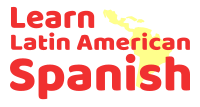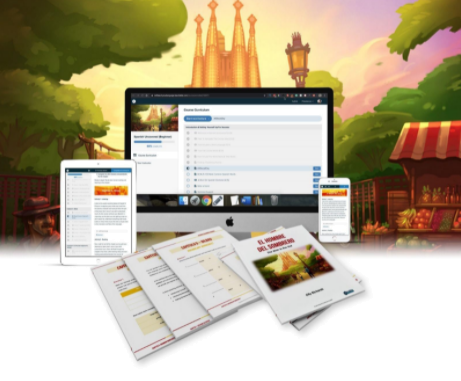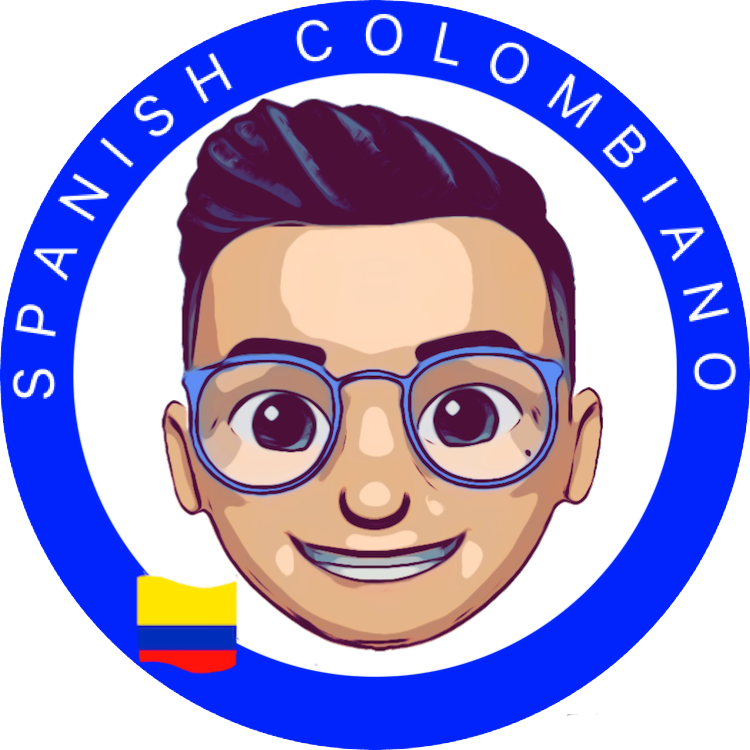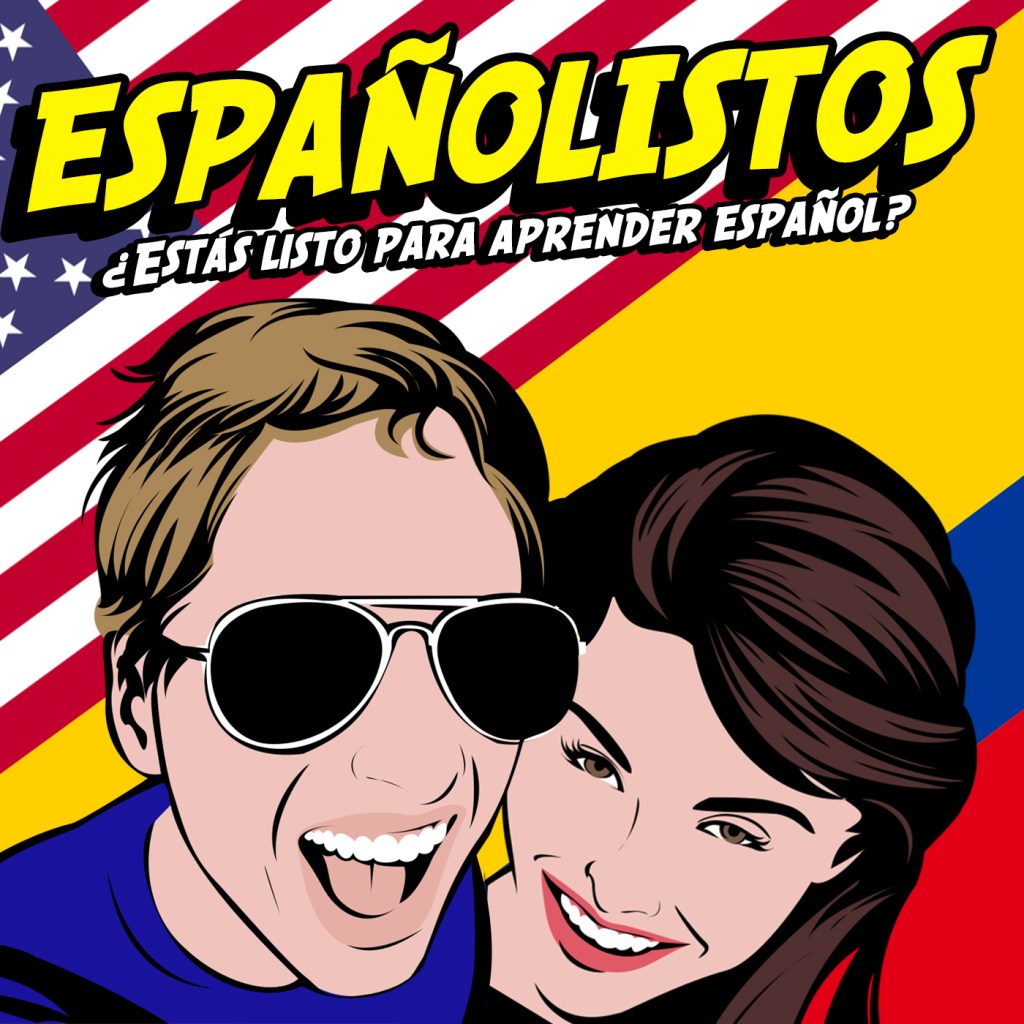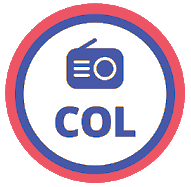|
Learn Colombian Spanish: A Spanish Course for Colombia (Audiobook)
A Spanish course for Colombia, teaching basic Spanish as well as the nuances as of the language and slang commonly used in Colombia. This introductory audio course spans 10 sessions including topic-based vocabulary using sound effects to aid recall of key terms as well as lots of games and music to keep you engaged. Topics covered include numbers, greetings, manners, foods, animals, vehicles, colors, places, time, positions the weather, verbs, cognates, simple grammar, and many others. The content is also structured to repeat across sessions in different ways to aid your ability to learn it easily. There are also introductory grammar and pronunciation tips as well as specific detail on Colombia and its use of the Spanish language. This is a great resource if you are travelling to Colombia for work or for pleasure and will allow you to better understand and communicate to fully experience the culture of this unique and important nation. |
An Overview of Colombian Spanish
Native speakers: 49 million.
Colombian Spanish is a grouping of the varieties of Spanish spoken in Colombia. The term is of more geographical than linguistic relevance, since the dialects spoken in the various regions of Colombia are quite diverse. The speech of coastal areas tends to exhibit phonology typical of Caribbean Spanish, while highland varieties do not. The Caro and Cuervo Institute in Bogotá is the main institution in Colombia to promote the scholarly study of the language and literature of both Colombia and the rest of Spanish America. The educated speech of Bogotá, a generally conservative variety of Spanish, has high popular prestige among Spanish-speakers throughout the Americas.
Linguists recognize eleven dialect areas of Colombian Spanish, as listed below.
Paisa dialect
The Paisa dialect is spoken in the Colombian coffee production areas, such as Antioquia, Quindío, Risaralda, Caldas, and the northernmost parts of Tolima and Valle del Cauca. Paisa Spanish has an apicoalveolar [s̺], between [s] and [ʃ], as in northern and central Spain. Paisa Spanish, a "voseante" dialect, often uses vos, rather than tú, for the familiar singular "you" pronoun.
Rolo dialect
"Rolo" (a name for the dialect of Bogotá) is also called cachaco. It is an area of strong ustedeo, the familiar use of the pronoun usted. The dialect follows many patterns similar to those of the Cundiboyacense dialect (preservation of syllable-final [s], preservation of /d/ in the -ado ending, preservation of the ll/y contrast (i.e., no yeísmo), etc.), but it had only marginal use of the formal second-person pronoun sumercé.
Cundiboyacense dialect
The Cundiboyacense dialect is spoken mainly in the departments of Cundinamarca and Boyacá (Cundiboyacense High Plateau). It uses the expression sumercé or su merced (literally "your grace") often as a formal second-person singular pronoun. The pronoun usted is used when two people speak in an informal situation. Tuteo (the use of the pronoun tú) is usual in conversation between a man and woman of similar ages. Occasionally, the pronoun usted may be used briefly in extremely-informal speech between couples or family members or to reprehend someone, depending on the tone of voice.
Caribbean dialect
The Caribbean or Coastal (costeño) dialect is spoken in the Caribbean Region of Colombia. It shares many of the features typical of general Caribbean Spanish and is phonologically similar to Andalusian and Canarian Spanish. Word-final /n/ is realized as velar [ŋ]. Syllable-final /s/ is typically pronounced [h] and so costa ("coast") is pronounced [ˈkohta] and rosales ("roses") becomes [roˈsaleh]. The most notable and distinguishable varieties of Atlantic- Colombian accents are Barranquilla (Considered the most l-articulated Spanish in America and mostly rhotic in upper-class speakers), Cartagena (mostly non-rhotic and fast-spoken) and Montería (Sinú Valley Accent, strictly non-rhotic, plosive and very marked wording like Received Pronunciation in British English), and all varieties avoid using r.
Island dialect
This is the dialect spoken in the Islands of San Andrés, Providencia, and Santa Catalina in Colombia's Caribbean Region. It is marked by a mixture of Caribbean Spanish with some features of English. Syllable-final /r/ can be realized, in addition to the flap [ɾ], the trill [r], and the lateral [l], as the alveolar approximant [ɹ], the last being thought to be an influence of British English. Thus, verso ("verse") becomes [ˈbeɹso] (alongside [ˈbeɾso], [ˈberso], or [ˈbelso]); invierno ("winter") becomes [imˈbjeɹno] (alongside [imˈbjeɾno], [imˈbjerno], or [imˈbjelno]), and escarlata ("scarlet") becomes [ehkaɹˈlata] (alongside [ehkaɾˈlata], [ehkarˈlata], or [ehkaˈlata]).
Word-final /r/, when followed by a vowel-initial word, is usually realized as a tap, an approximant, or the lateral [l], as in amo[ɾ~ ɹ ~ l] eterno ("eternal love"). If it is when followed by a consonant or a pause, it may be realized as any of those sounds or as a trill or elided, as in amo[r ~ ɾ ~ ɹ ~ l] paterno ("paternal love").
That phonetic characteristic is not exclusive to Colombians, whose ancestry is traced back to the Spanish period before the British invasion, under British territorial rule, and the recovery of Spanish control. It is also used by Raizals, by whites of British descent, and by descendants of mainland Colombians. The dialect of native Spanish-speakers in the area is closer to the Nicaraguan dialect of the Caribbean coast, reflecting the geographical location of the archipelago, off the coast of Nicaragua.
Valluno dialect
The Valluno dialect is spoken in the valley of the Cauca River between the Western and Central cordilleras. In Cali, the capital of Valle del Cauca, there is strong use of voseo (the use of the pronoun vos instead of other dialects, which use tú), with its characteristic verb forms.
The Valluno dialect has many words and phrases not used outside of the region. People commonly greet one another with the phrase "¿Q'hubo vé, bien o qué?". Also, it is common to be asked "¿Sí o no?" when assessing agreement to rhetorical statements. Thong sandals are referred to as chanclas, and plastic bags (bolsas elsewhere) are called chuspas. As in other areas, a chocha is another crude word for "vagina," and chucha refers to an opossum. A pachanguero is someone who dances or parties all night long.
Pastuso dialect
The Pastuso dialect is spoken in the southwest ll of the country. One feature is apicoalveolar [s̺], between [s] and [ʃ], as in northern and central Spain. However, unlike Paisa, speakers typically conserve the "ll"/"y" distinction (the dialect has no yeísmo), and in some areas, the r is pronounced as a voiced apical sibilant. Contrary to the usual tendency in Spanish to weaken or relax the sounds /b/, /d/, and /ɡ/ between vowels, Pastuso-speakers tend to tense those sounds with more emphasis than in other dialects.
Opita dialect
The Opita dialect is spoken mostly in the departments of Tolima and Huila, mostly in the central and southern parts of the Magdalena River Valley. It is said to show strong influence of indigenous languages and is noted for its slow tempo and unique intonation. As in most of the Americas, the dialect has yeísmo and seseo. The dialect is traditionally characterized by the use of the second-person pronoun usted (or vusted in some rural areas) in formal circumstances but also in familiar ones (in which most other dialects would use tú, see "ustedeo" above). However, tú is gaining ground with young people. The use of voseo is rare.
Santanderean dialect
Santanderean is spoken mostly in the northeastern part of the country in Santander and Norte de Santander Departments. There is a strong use of ustedeo in both informal and formal contexts.
Llanero or Eastern plains dialect
Llanero covers a vast area of the country with a low population density. It is spoken in the eastern plains of the country from the Cordillera Oriental (the eastern mountain range of the Andes). It has a characteristic influence of inland Colombian settlers.
Chocó or Pacific dialect
This dialect extends beyond the Department of Chocó throughout the Pacific coast and is said to reflect African influence in terms of intonation and rhythm. Characteristically, syllable-final /s/ is frequently either debuccalized and pronounced as [h] or omitted, as in the Caribbean dialect (see above). Like the Caribbean dialect, word-final /n/ is realized as velar [ŋ], /d/ is replaced by /r/ in some words, and syllable-final /l/ and /r/ are often merged, as in Caribbean Spanish. This dialect is also spoken by Afro-Colombians living inland in the departments of Cauca and Valle del Cauca.
Source: Wikipedia
Colombian Spanish is a grouping of the varieties of Spanish spoken in Colombia. The term is of more geographical than linguistic relevance, since the dialects spoken in the various regions of Colombia are quite diverse. The speech of coastal areas tends to exhibit phonology typical of Caribbean Spanish, while highland varieties do not. The Caro and Cuervo Institute in Bogotá is the main institution in Colombia to promote the scholarly study of the language and literature of both Colombia and the rest of Spanish America. The educated speech of Bogotá, a generally conservative variety of Spanish, has high popular prestige among Spanish-speakers throughout the Americas.
Linguists recognize eleven dialect areas of Colombian Spanish, as listed below.
Paisa dialect
The Paisa dialect is spoken in the Colombian coffee production areas, such as Antioquia, Quindío, Risaralda, Caldas, and the northernmost parts of Tolima and Valle del Cauca. Paisa Spanish has an apicoalveolar [s̺], between [s] and [ʃ], as in northern and central Spain. Paisa Spanish, a "voseante" dialect, often uses vos, rather than tú, for the familiar singular "you" pronoun.
Rolo dialect
"Rolo" (a name for the dialect of Bogotá) is also called cachaco. It is an area of strong ustedeo, the familiar use of the pronoun usted. The dialect follows many patterns similar to those of the Cundiboyacense dialect (preservation of syllable-final [s], preservation of /d/ in the -ado ending, preservation of the ll/y contrast (i.e., no yeísmo), etc.), but it had only marginal use of the formal second-person pronoun sumercé.
Cundiboyacense dialect
The Cundiboyacense dialect is spoken mainly in the departments of Cundinamarca and Boyacá (Cundiboyacense High Plateau). It uses the expression sumercé or su merced (literally "your grace") often as a formal second-person singular pronoun. The pronoun usted is used when two people speak in an informal situation. Tuteo (the use of the pronoun tú) is usual in conversation between a man and woman of similar ages. Occasionally, the pronoun usted may be used briefly in extremely-informal speech between couples or family members or to reprehend someone, depending on the tone of voice.
Caribbean dialect
The Caribbean or Coastal (costeño) dialect is spoken in the Caribbean Region of Colombia. It shares many of the features typical of general Caribbean Spanish and is phonologically similar to Andalusian and Canarian Spanish. Word-final /n/ is realized as velar [ŋ]. Syllable-final /s/ is typically pronounced [h] and so costa ("coast") is pronounced [ˈkohta] and rosales ("roses") becomes [roˈsaleh]. The most notable and distinguishable varieties of Atlantic- Colombian accents are Barranquilla (Considered the most l-articulated Spanish in America and mostly rhotic in upper-class speakers), Cartagena (mostly non-rhotic and fast-spoken) and Montería (Sinú Valley Accent, strictly non-rhotic, plosive and very marked wording like Received Pronunciation in British English), and all varieties avoid using r.
Island dialect
This is the dialect spoken in the Islands of San Andrés, Providencia, and Santa Catalina in Colombia's Caribbean Region. It is marked by a mixture of Caribbean Spanish with some features of English. Syllable-final /r/ can be realized, in addition to the flap [ɾ], the trill [r], and the lateral [l], as the alveolar approximant [ɹ], the last being thought to be an influence of British English. Thus, verso ("verse") becomes [ˈbeɹso] (alongside [ˈbeɾso], [ˈberso], or [ˈbelso]); invierno ("winter") becomes [imˈbjeɹno] (alongside [imˈbjeɾno], [imˈbjerno], or [imˈbjelno]), and escarlata ("scarlet") becomes [ehkaɹˈlata] (alongside [ehkaɾˈlata], [ehkarˈlata], or [ehkaˈlata]).
Word-final /r/, when followed by a vowel-initial word, is usually realized as a tap, an approximant, or the lateral [l], as in amo[ɾ~ ɹ ~ l] eterno ("eternal love"). If it is when followed by a consonant or a pause, it may be realized as any of those sounds or as a trill or elided, as in amo[r ~ ɾ ~ ɹ ~ l] paterno ("paternal love").
That phonetic characteristic is not exclusive to Colombians, whose ancestry is traced back to the Spanish period before the British invasion, under British territorial rule, and the recovery of Spanish control. It is also used by Raizals, by whites of British descent, and by descendants of mainland Colombians. The dialect of native Spanish-speakers in the area is closer to the Nicaraguan dialect of the Caribbean coast, reflecting the geographical location of the archipelago, off the coast of Nicaragua.
Valluno dialect
The Valluno dialect is spoken in the valley of the Cauca River between the Western and Central cordilleras. In Cali, the capital of Valle del Cauca, there is strong use of voseo (the use of the pronoun vos instead of other dialects, which use tú), with its characteristic verb forms.
The Valluno dialect has many words and phrases not used outside of the region. People commonly greet one another with the phrase "¿Q'hubo vé, bien o qué?". Also, it is common to be asked "¿Sí o no?" when assessing agreement to rhetorical statements. Thong sandals are referred to as chanclas, and plastic bags (bolsas elsewhere) are called chuspas. As in other areas, a chocha is another crude word for "vagina," and chucha refers to an opossum. A pachanguero is someone who dances or parties all night long.
Pastuso dialect
The Pastuso dialect is spoken in the southwest ll of the country. One feature is apicoalveolar [s̺], between [s] and [ʃ], as in northern and central Spain. However, unlike Paisa, speakers typically conserve the "ll"/"y" distinction (the dialect has no yeísmo), and in some areas, the r is pronounced as a voiced apical sibilant. Contrary to the usual tendency in Spanish to weaken or relax the sounds /b/, /d/, and /ɡ/ between vowels, Pastuso-speakers tend to tense those sounds with more emphasis than in other dialects.
Opita dialect
The Opita dialect is spoken mostly in the departments of Tolima and Huila, mostly in the central and southern parts of the Magdalena River Valley. It is said to show strong influence of indigenous languages and is noted for its slow tempo and unique intonation. As in most of the Americas, the dialect has yeísmo and seseo. The dialect is traditionally characterized by the use of the second-person pronoun usted (or vusted in some rural areas) in formal circumstances but also in familiar ones (in which most other dialects would use tú, see "ustedeo" above). However, tú is gaining ground with young people. The use of voseo is rare.
Santanderean dialect
Santanderean is spoken mostly in the northeastern part of the country in Santander and Norte de Santander Departments. There is a strong use of ustedeo in both informal and formal contexts.
Llanero or Eastern plains dialect
Llanero covers a vast area of the country with a low population density. It is spoken in the eastern plains of the country from the Cordillera Oriental (the eastern mountain range of the Andes). It has a characteristic influence of inland Colombian settlers.
Chocó or Pacific dialect
This dialect extends beyond the Department of Chocó throughout the Pacific coast and is said to reflect African influence in terms of intonation and rhythm. Characteristically, syllable-final /s/ is frequently either debuccalized and pronounced as [h] or omitted, as in the Caribbean dialect (see above). Like the Caribbean dialect, word-final /n/ is realized as velar [ŋ], /d/ is replaced by /r/ in some words, and syllable-final /l/ and /r/ are often merged, as in Caribbean Spanish. This dialect is also spoken by Afro-Colombians living inland in the departments of Cauca and Valle del Cauca.
Source: Wikipedia
Colombian Spanish Learning Books
|
Colombian Spanish: Phrases, expressions and tips to help you speak like a local
This book is an innovative and comprehensive guide to the Spanish spoken in Colombia. Written by a long-term Colombia expat and editor of a blog on Colombian Spanish, it is packed with tips to help you move away from speaking ‘gringo Spanish’ to mastering the language as it is actually spoken in Colombia. Unlike most language books, which contain nothing but grammar and written exercises, Colombian Spanish is an easily accessible tour through the language heard in everyday social situations in the country. The book explains how to use hundreds of 'colombianismos', and provides all the linguistic tools you’ll need to make friends, date, charm and joke around with the locals. Don't leave for Colombia without it. |
|
Colombian Slang: 500 words that help you feel like a local in Colombia
Each country that we explore offers a different culture that is ready to be discovered, taking from us until the last breath and stripping us down to the most intimate smile that comes directly from the soul. We create magic every time we free ourselves from our boundaries and beliefs, allowing us the beauty of connecting with cultures which were possibly previously unknown, but which broaden our minds and provide us with new ideas. For this reason, with this book, the author wants you to open your mind and your heart to this beautiful country which has so much to offer. Allow yourself to be surprised by the Colombian people because language is what connects us, unites us and allows us to foster empathy. This book has the necessary Colombian magic to help you feel "at home" while you travel around Colombia. |
|
Colombia: Spanish Travel Phrases for English Speaking Travelers
This is the solution for your communication problems when you travel to Colombia. You can access the phrase you need by using a clickable table of contents that will lead you to the topic you are looking for: Bank, Bar, Boutique, Bus travel, Business meetings, Café, Car accidents, Car rental, Car travel, Children, Cinema, Communication, Consulate, Customs, Directions, Discomfort, Embassy, Gas station, Hairdresser, Health, Hotel, Luggage, Metro travel, Money, Passport, Personal accidents, Personal information, Phone, Plane and airport, Professions, Restaurant, Supermarket, Taxi, Theatre, Time and date, Train travel, Visa, Weather, or you can find the phrase you need by searching the keyword in the “search and find” tab of your mobile device. When you find it you can show the phrase in you mobile device to the person and solve the problem right away! |
|
Quick Guide to Colombian Spanish
This dictionary-style book of words and phrases helps you better understand Colombian Spanish and slang. The collection of more than 450 terms and sayings will help you become familiar with the richness of the country’s Spanish. It includes slang and vulgar words that you will likely run across in everyday conversations. Each term has been defined in English and synonyms are included when available. There are also more than 450 example sentences demonstrating how to use the words. You will be on your way to Colombian Spanish fluency with this phrasebook of Spanish vocabulary words from Colombia. This book contains words that are not appropriate for kids. If you are just starting to learn Spanish, this book is best used as a complementary reference source to any program or class designed to teach you Spanish. This book and the other books of the Speaking Latino series are not designed as stand-alone learning aids, to teach you Spanish. Instead, they expand your country-specific Spanish vocabulary. If you already speak Spanish, this book help you understand local Spanish from Colombia. |
|
Short Stories in Colombian Spanish
Experience Colombian Culture and Enhance Your Spanish with 20 Vibrant Short Stories and Key Vocabulary Explore the vibrant tapestry of Colombian culture while enhancing your Spanish skills with this captivating collection of short stories. Immerse yourself in the everyday experiences of diverse characters as they navigate life in Colombia, providing you with a unique window into the rich cultural heritage of this fascinating country. Discover the nuances of Colombian life through 20 engaging short stories, each offering a snapshot of daily experiences, traditions, and authentic interactions. Immerse yourself in a broad and varied vocabulary specific to Colombian Spanish. Over 100 carefully selected words are provided at the end of each story, acting as a valuable learning guide to expand your language skills. |
|
Peter va a Colombia (Spanish Edition)
An engaging, action-packed read, Peter va a Colombia is a short novel that first-year Spanish students can easily grasp. Written in the present tense, the book is built on a list of 350-plus Spanish nouns, verbs, and common expressions. As they read, students acquire basic vocabulary and grammar but also learn about fascinating places and people in Colombia. The main character is 13-year-old Peter from the United States, who learns about Colombia from his Spanish teacher and decides to visit. But once there surprises meet him at every turn. Drawing readers to Peter’s adventure, this book keeps students engaged and involved. As they read, they will wonder: What is Bogota like? What foods do Colombians enjoy? Do poor Colombian children enjoy books as much as they do? In this book students will find answers to these and other questions. |
|
¡Papacito!
Valeria has fallen hard for Juan Carlos, a handsome boy from her high school. She is willing to do whatever it takes to win his heart. Unfortunately, her schemes often end up putting her into awkward and hilarious situations. How will she convince her strict parents to let her have a boyfriend? What will her jealous frenemy, Malina do next to sabotage her attempts to make Juan Carlos fall deeply and madly in love with her? Set in beautiful and historic Cartagena, Colombia and filled with cultural references throughout; ¡Papacito! has 130 unique words and numerous cognates. Written in the present tense and with dramatic illustrations on every page, ¡Papacito! is a compelling and comprehensible novel for Novice level readers and above. |
Colombian Spanish Language Courses
|
1-on-1 Spanish tutoring at italki
One-on-one language tutoring at italki is hands down the most efficient way to reach language fluency. That's why it is the most popular platform today for learning a language online. You can practice conversational skills under different real-world scenarios with a native speaker tutor of your choice who provides you with undivided attention and customized lessons that cater to your learning needs and interests. Whether you’re at home, at the airport, or at your local park, you have complete access to learning Colombian Spanish or any other language you want with a native speaker from any country of your choice. SPECIAL OFFER: Get $10 italki credits by joining via this link. |
|
Spanish Uncovered: The World’s First StoryLearning Spanish Home Study Course
This new, science-based language learning method was invented by polyglot language expert Olly Richards, who has authored more than a dozen best-selling language books available in bookstores around the world and on Amazon.com. This was the method he used to learn eight languages, and is the exact same method he has been using to help thousands of students learn Spanish. The course comes in both Castilian and Latin American versions, which means that it works for you whatever variety of Spanish you're learning. Find out more! |
|
Baselang's Real World 1-on-1 Spanish tutoring
This top-rated program offers UNLIMITED 1-on-1 Spanish tutoring where you can take as many online Spanish classes as you want, on a daily basis if you wish, with their professional teachers from all around Latin America for a monthly flat rate. Baselang's classes are specifically tailored to your level, from zero to advanced. Don't miss this amazing opportunity! |
|
Preply
Preply is a global online language learning platform designed to promote faster learning with one-on-one online tutors. It connects language tutors with millions of learners from all over the world. You can choose from thousands of Spanish teachers from any country of your choice available in the platform. Book a lesson with a private Spanish teacher today and start learning. Not entirely happy with your tutor? No worries, Preply offers free tutor replacement till you're 100% satisfied. |
|
Colombian Spanish Course by Peter Low
A unique course that teaches you the Spanish you'll need to make friends, have fun, date and get the most out of your time in Colombia. You'll learn how to interact confidently in Spanish conversations from an engaging and entertaining mix of video lessons, teacher interviews, quizzes and study tasks. Focused exclusively on the phrases and expressions that you'll hear when chatting, making friends and going out with Colombians, it's Spanish you can use in conversations straightaway. |
Colombian Spanish Learning Podcasts
|
Podcasts by Jorge at SpanishColombiano.com
Spanish Colombiano is a platform created by Jorge, a friendly Colombian guy currently living in Australia, for people who want to learn Colombian Spanish while learning about the culture, history and current affairs of Colombia and South America. Having moved to Australia where he has studied, made friends and now works as an engineer, Jorge understands all the challenges and joys that come with becoming fluent in a second language. He has picked up many tricks and tips over the years to share with you, fellow language learners, on how to improve your fluency, enhance your pronunciation, and get through the dreaded plateau phase. His podcasts are suitable for people who want to travel to South America and/or want to know more about latino culture, history and people, as well as people who like to listen to latino music, dance salsa, bachata or Reggaeton, and want to know the history and culture behind the lyrics. |
|
Españolistos
Españolistos is a Colombian Spanish language learning Podcast geared towards intermediate to advanced language learners. The conversations are 99% in Spanish so you can focus on your listening comprehension. The topics are fun and interesting, sometimes controversial, and always educational. We believe that discussing deep and meaningful topics will increase your vocabulary as you learn new and practical words for everyday living. |
|
Podcast on Colombia by Lengalia
Listen to native speakers from Colombia telling interesting facts about their country, culture and language in Colombian Spanish accent. |
Colombian Spanish Learning Blogs
|
Colombian Slang Words You Won’t Learn In Spanish School
An excellent blog article on Colombian Spanish slang by Baselang. With Baselang's UNLIMITED 1-on-1 online Spanish tutoring you can take as many online Spanish classes as you want with their professional teachers for a monthly flat rate. Don't miss the opportunity! |
|
Interesting and Confusing Aspects of Colombian Spanish
A refreshing and eye-opening article on Colombian Spanish by Benny Lewis, the polyglot founder and CEO of Fluent in 3 Months, an online platform (also title of a book he authored) on which he documents his personal attempts to learn different languages within short time periods, typically three months. |
|
¡Qué Chimba! 79 Cool Colombian Slang Words You’ve Gotta Know
A great blog article on Colombian Spanish slang by FluentU. |
Colombian Spanish Learning Apps
|
Colombian Spanish Basic Phrases - On Google Play
This app was originally developed as an entry to the 2010 "Apps for the Army" competition, and it is based on the modules publicly available online from the US Defense Language Institute. While this app's subject matter relates mainly to military topics, the app is broadly useful with content relating to a range of topics including Greetings and Introductions, Numbers, Days of the Week/Time, Directions, Locations, Descriptions (Colors, Shapes, Sizes, Tastes, Qualities, Quantities), Emergency Terms, Food and Sanitation, Fuel and Maintenance, Lodging, Medical Terms, Military Ranks, Occupations, Parts of the Body, Relatives and Weather. |
|
Radio Colombia FM Online - On Google Play Hands down the best radio app to listen to FM radio stations from all over Colombia. This app allows you to listen live all Colombian radio broadcasts for free and online. The ergonomics of Radio Colombia have been designed to be the simplest and fastest radio application. An indispensable tool to boost your Colombian Spanish listening skills. |
1-on-1 Colombian Spanish Lessons at italki
|
italki is the most flexible and affordable language learning platform that connects students with the most dedicated teachers around the world for 1-on-1 online language tutoring through video chat. At italki, you can choose an experienced Colombian Spanish teacher for your personal tutor based on your goals and interests.
Here is a step-by-step instruction to find a native Colombian Spanish teacher at italki:
Good luck and enjoy your lesson! |
Home | About | Contact Us | Disclosure | Privacy Policy
This page contains affiliate links. For more information, see our disclosure page.
Copyright © 2024 LearnLatinAmericanSpanish.com
This page contains affiliate links. For more information, see our disclosure page.
Copyright © 2024 LearnLatinAmericanSpanish.com
